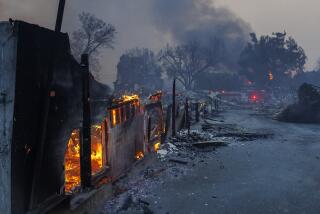On View: ‘The Arts of Survival: Folk Expression in the Face of Disaster’
- Share via
In an unfortunate coincidence, days before “The Arts of Survival: Folk Expression in the Face of Disaster” was scheduled to open at the Museum of International Folk Art in Santa Fe, N.M., raging wildfires forced the evacuation of nearby Los Alamos nuclear lab.
“There was still smoke in the air,” curator Suzanne Seriff said. An interactive section where visitors can talk about their experiences with extreme weather was added to the exhibition, which explores how folk artists helped their communities recover from four recent natural disasters: the Haitian earthquake, Pakistani floods, Indonesia’s Mt. Merapi’s volcanic eruption and Hurricane Katrina.
“I’m a child of the late ‘60s and thought of the theme of earth, wind and fire. A natural disaster caused by each of these elements gone awry in 2010. I also wanted to include the U.S., which is how Katrina was selected.”
Some 30 pieces by 11 artists are on display. Many of the artists also participated in the annual Santa Fe International Folk Art Market that opened concurrently with the show.
The works include paintings, masks, scrolls, vodou flags and puppets. Haitian papier mâché artist Onel Bazelais created a Carnival-like mask with a big brick through the head. A group of kids in Haiti from a radical art collective recycled debris into collages and sold them on the streets. The profits were used for schools and makeshift homes.
Several Ralli Purrs from Pakistan are on view. Women fleeing the flood waters grabbed the quilt tops, which are used as dowry pieces. “In dire situations they can sell them,” Seriff said. Rallis were also made from unused clothing donated from around the world.
Javan shadow puppeteer Ki Enthus Susmono gave benefit performances in the relief camps to help lift evacuees spirits after the Mt. Merapi eruption. “Indonesians are very familiar with him and his presence brought comfort to displaced families who lost their homes,” museum director Marsha Bol said.
The study of folk art is defined as the expression of cultural identity by self taught artists. “The work they produce expresses the aesthetics of the community and its people,” Bol said. “The Art of Survival” is the second show to be held in the Gallery of Conscience that examines social injustice and hardships facing folk artists in the 21st century.
Founded in 1953 by Chicago heiress Florence Dibell Bartlett, the museum says it has the world’s largest collection of folk art with more than 135,000 artifacts.
“We did not want this to be known as the natural disaster exhibit,” Seriff said. “It’s about the incredible spirit and ways folk artists respond by trying to help with the economic recovery and by eulogizing the dead.” At the opening, a member of Yo-Yo Ma’s Silk Road Ensemble played a flute tribute originally written in 1923 after the Great Kanto Earthquake to those who died in the Japan earthquake and tsunami in March.
When asked why she wanted to depict such horrible scenes of death and destruction in her Haitian vodou flag, Mireille Delismé said: “It’s my family and I have to tell their story.”
More to Read
The biggest entertainment stories
Get our big stories about Hollywood, film, television, music, arts, culture and more right in your inbox as soon as they publish.
You may occasionally receive promotional content from the Los Angeles Times.










